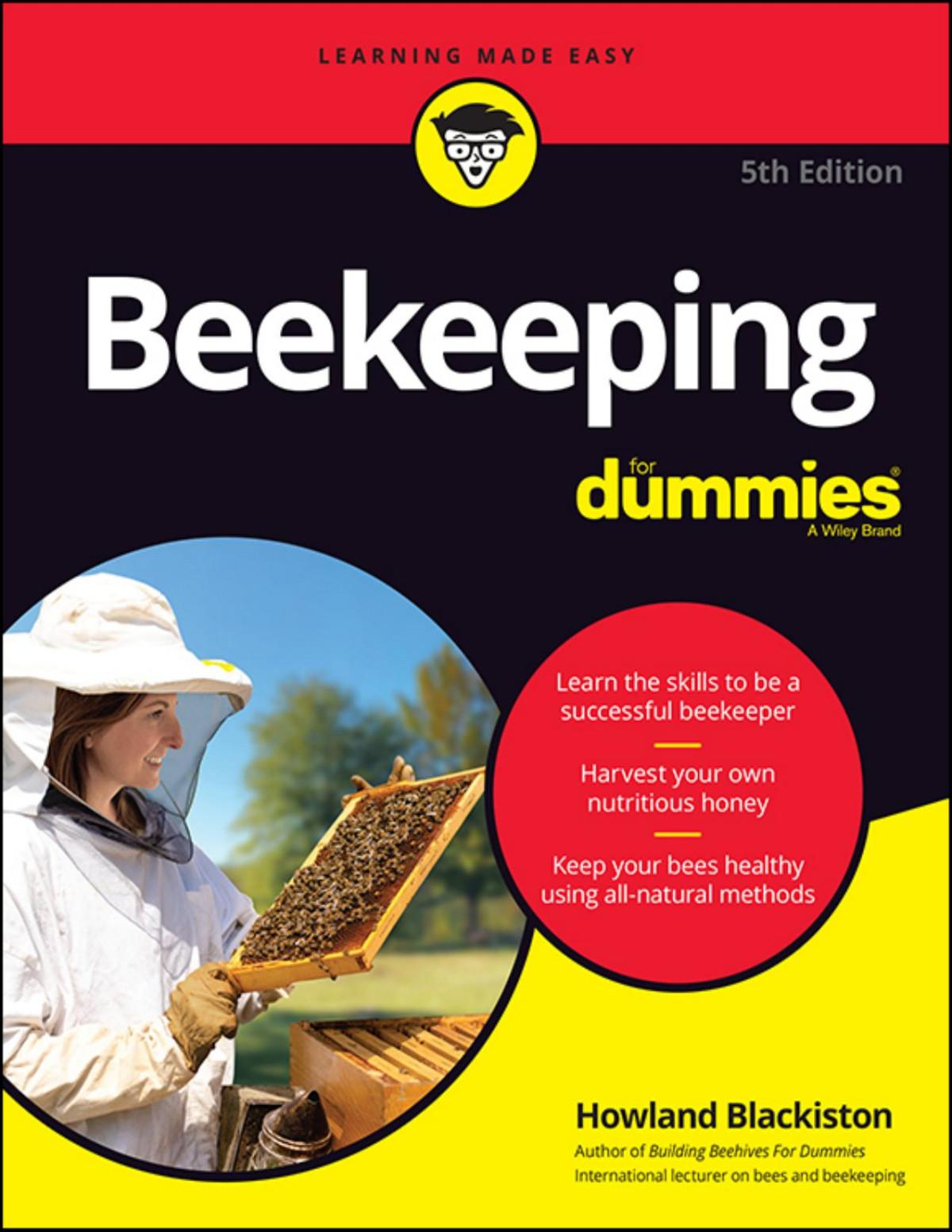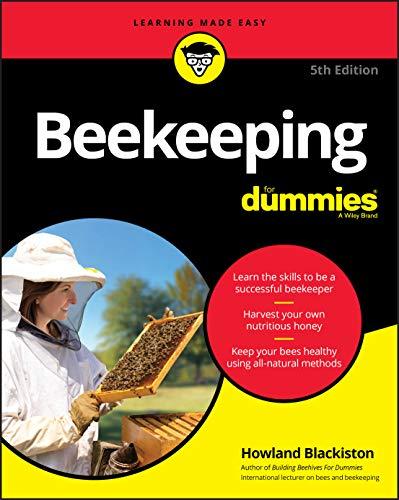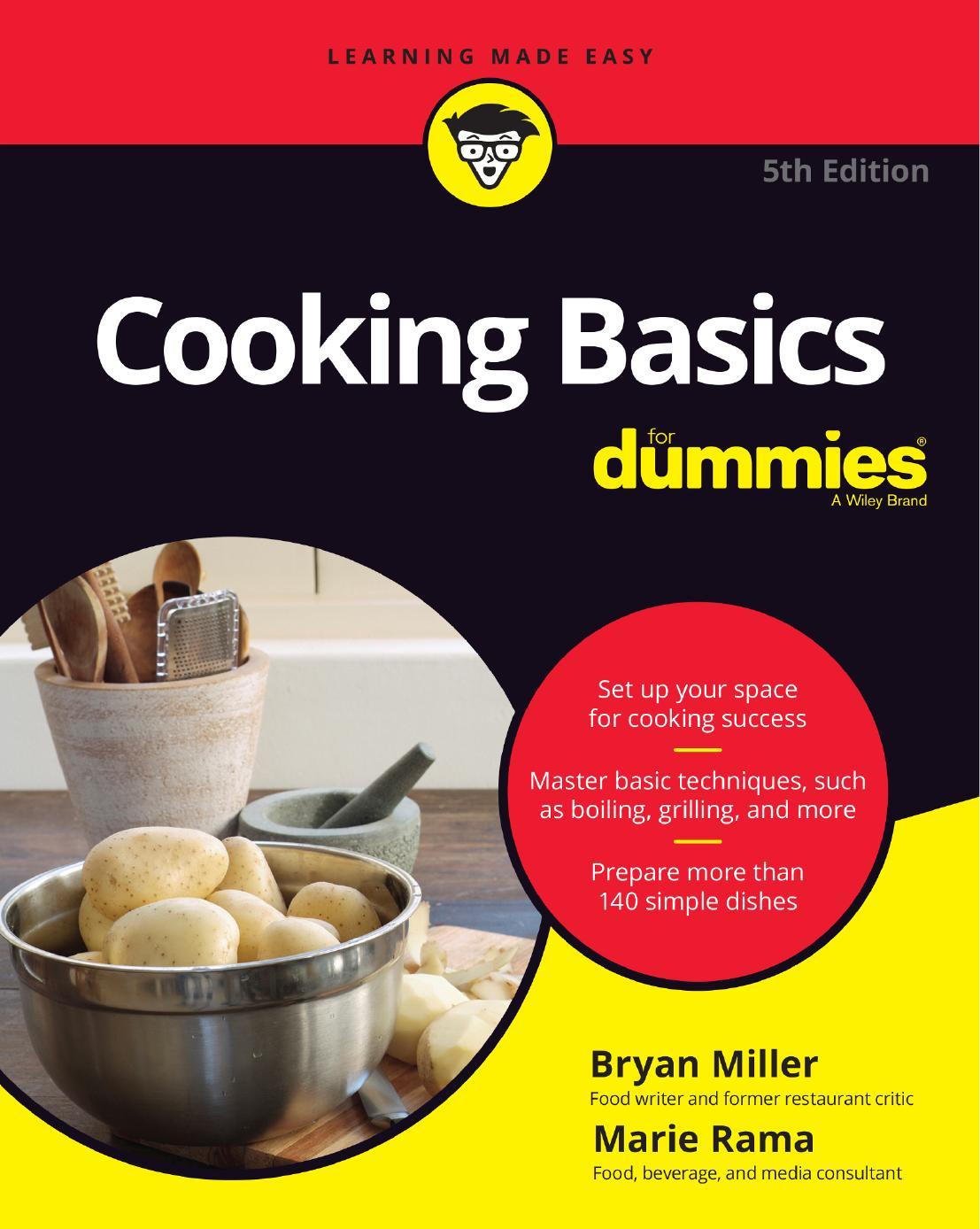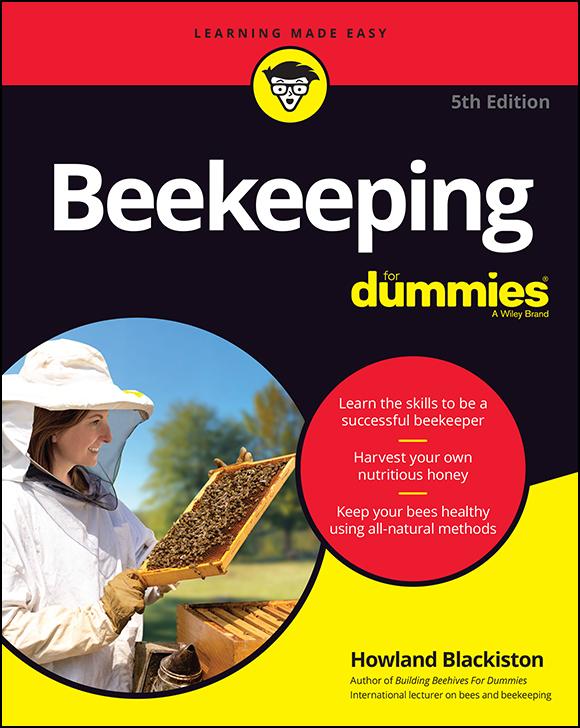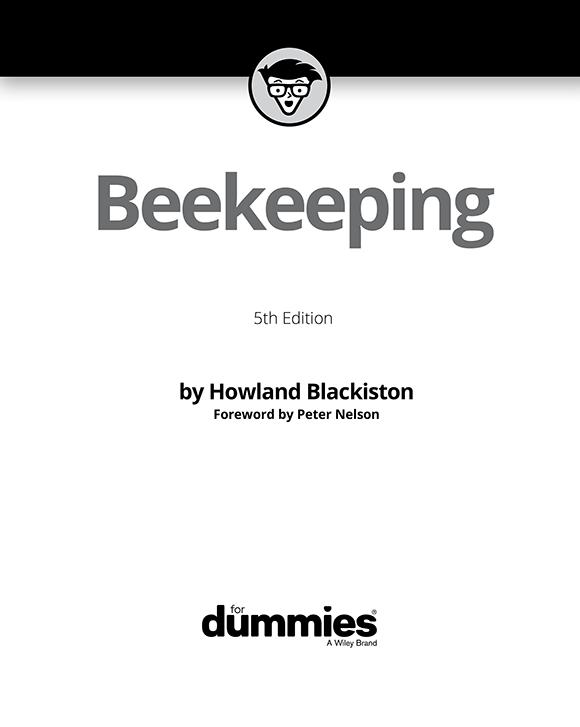Beekeeping For Dummies®
To view this book's Cheat Sheet, simply go to www.dummies.com and search for “Beekeeping For Dummies Cheat Sheet” in the Search box.
Table of Contents
Cover Introduction About This Book
Foolish Assumptions
Icons Used in This Book Beyond the Book
Where to Go from Here
Part 1: Taking Flight with Beekeeping
Chapter 1: To Bee, or Not to Bee?
Discovering the Benefits of Beekeeping
Determining Your Beekeeping Potential Deciding Which Beekeeping Approach to Follow
Chapter 2: Getting to Know Your Honey Bees
Basic Body Parts
The Amazing Language of Bees
Getting to Know the Male and the Two Female Castes
The Honey Bee Life Cycle
Other Stinging Insects
Part 2: Starting Your Adventure
Chapter 3: Alleviating Apprehensions and Making Decisions
Overcoming Sting Phobia
Understanding Local Laws and Ordinances
Easing the Minds of Family and Neighbors
Location, Location, Location: Where to Keep Your Hives
Knowing When to Start Your Adventure
Chapter 4: Selecting a Hive That’s Perfect for You
The Langstroth Hive
The Kenyan Top Bar Hive
The Apimaye Insulated Hive
The Flow Hive
The Warré (People’s) Hive
The Five-Frame Nuc Hive
The Observation Hive
Make a Beeline to the Best Beehive
Chapter 5: Basic Equipment for Beekeepers
Starting Out with the Langstroth Hive
Knowing the Basic Woodenware Parts of the Langstroth Hive
Knowing the Basic Parts of a Top Bar Hive
Ordering Hive Parts
Adding on Feeders
Fundamental Tools
Bee-Proof Clothing
Really Helpful Accessories
Chapter 6: Obtaining and Installing Your Bees
Determining the Kind of Bee You Want
Deciding How to Obtain Your Initial Bee Colony
Picking a Reputable Bee Supplier
Deciding When to Place Your Order
The Day Your Girls Arrive
Putting Your Bees into the Hive
Part 3: Time for a Peek
Chapter 7: Opening Your Hive
Establishing Visiting Hours
Setting an Inspection Schedule
Preparing to Visit Your Langstroth or Top Bar Hive
Lighting Your Smoker
Opening a Langstroth Hive
Opening a Top Bar Hive
The Hive’s Open! Now What?
Chapter 8: What to Expect When You’re Inspecting
Keeping a Journal
Inspecting a Langstroth Hive
Inspecting a Top Bar Hive
Understanding What to Always Look For Your New Colony’s First Eight Weeks
Chapter 9: Different Seasons, Different Activities
Lazy, Hazy, Crazy Days of Summer
Falling Leaves Point to Autumn Chores
Clustering in a Winter Wonderland
Spring Is in the Air (Starting Your Second Season)
Managing Top Bar Hives in the Spring
The Beekeeper’s Calendar
Part 4: Common Problems and Simple Solutions
Chapter 10: Anticipating and Preventing Potential Problems
Running Away (to Join the Circus?)
Where Did the Queen Go?
Avoiding Chilled Brood
Dealing with the Dreaded Robbing Frenzies
Ridding Your Hive of the Laying Worker Phenomenon
Preventing Pesticide Poisoning
The “Killer Bee” Phenomenon
Chapter 11: Colony Collapse Disorder
What Is CCD?
What to Do If You Suspect CCD
Why All the Fuss?
What’s Causing CCD?
Answers to FAQs
What You Can Do to Help
Chapter 12: Keeping Your Bees Healthy
Understanding the Importance of Good Nutrition
Medicating or Not?
Knowing the Big-Six Bee Diseases
Chapter 13: Heading Off Honey-Bee Pests
Parasitic Problems
Other Unwelcome Pests
Pest Control at a Glance
Chapter 14: Raising Your Own Queens
Why Raising Queens Is the Bee’s Knees
Understanding Genetics
What Makes a Queen a Queen
Talking about the Birds and Bees for Honey Bees
Creating Demand: Making a Queenless Nuc
Queen-Rearing Method 1: Go with the Flow
Queen-Rearing Method 2: The Miller Method
Queen-Rearing Method 3: The Doolittle Method, also Known as Grafting
Finding Homes for Your Queens
Evaluating the Results
The Queen Rearer’s Calendar
Marking Your Queens
Part 5: Sweet Rewards
Chapter 15: Honey, I Love You
Appreciating the History of Honey
Understanding the Composition of Honey
Healing with Honey
Choosing Extracted, Comb, Chunk, or Whipped Honey
Taking the Terror out of Terroir
The Commercialization of Honey
Appreciating the Culinary Side of Honey
Pairing Honey with Food
Infusing Honey with Flavors
Judging Honey
Honey Trivia
Chapter 16: Getting Ready for the Golden Harvest
Having Realistic Expectations
What Flavor Do You Want?
Assembling the Right Equipment to Extract Honey
Planning Your Extracted Honey Harvest Setup
Gathering Comb Honey Equipment
Branding and Selling Your Honey
Chapter 17: Honey Harvest Day
Knowing When to Harvest
Getting the Bees out of the Honey Supers
Honey Extraction from a Langstroth Frame
Harvesting Honey from Your Top Bar Hive
Harvesting Wax
Part 6: The Part of Tens
Chapter 18: More than Ten Fun Things to Do with Bees
Making Two Langstroth Hives from One
Making One Langstroth Hive from Two
Dividing a Top Bar Hive into Two Colonies
Combining Two Top Bar Hive Colonies
Building an Elevated Hive Stand
Planting Flowers for Your Bees
Brewing Mead: The Nectar of the Gods
Create Cool Stuff with Propolis
Making Gifts from Beeswax
Beauty and the Bees
Chapter 19: More than Ten Frequently Asked Questions about Bee Behavior
Chapter 20: My Ten Favorite Honey Recipes
Part 7: Appendixes
Appendix A: Helpful Resources
Honey Bee Information Websites
Bee Organizations and Conferences
The Western Apiculture Society
Bee Journals and Magazines
Beekeeping Supplies and Equipment
Western Bee Supplies
State Bee Inspectors (United States)
Appendix B: Beekeeper’s Checklist
Appendix C: Glossary
Index
About the Author
Supplemental Images
Connect with Dummies
End User License Agreement
List of Tables
Chapter 4
TABLE 4-1 Hive Checklist — Which Hive Meets Your Needs?
Chapter 6
TABLE 6-1 Characteristics of Various Common Honey Bee Types
Chapter 9
TABLE 9-1 Beekeeping Calendar
Chapter 11
TABLE 11-1 Pollination Experiments
Chapter 12
TABLE 12-1 Honey-Bee Health at a Glance
Chapter 13
TABLE 13-1 Solutions to Common Pest Problems
Chapter 17
TABLE 17-1 Estimating Honey Yields
Chapter 18
TABLE 18-1 Building Materials for Elevated Hive Stand
TABLE 18-2 Hive Stand Cut-and-Assemble Instructions
List of Illustrations
Chapter 2
FIGURE 2-1: This is how a honey bee looks if you shave off all the hairs. Sever...
FIGURE 2-2: Comparing the heads of worker, drone, and queen bees. Note the work...
FIGURE 2-3: In this close-up image of a worker bee’s leg, you can clearly see t...
FIGURE 2-4: The round dance (top) and the waggle dance (bottom).
FIGURE 2-5: These are the three types of bees in the hive: worker, drone, and q...
FIGURE 2-6: A queen and her attentive attendants.
FIGURE 2-7: This worker bee fans her wings while exposing her Nasonov gland to ...
FIGURE 2-8: This bee’s pollen baskets are filled. She can visit ten flowers eve...
FIGURE 2-9: Note the rice-like shape of the eggs and how the queen has position...
FIGURE 2-10: A single egg.
FIGURE 2-11: These magnifying goggles (used by watchmakers and model makers) ar
FIGURE 2-12: Beautiful, pearly white little larvae curled up in their cells.
FIGURE 2-13: Opened cells reveal an egg and developing pupae.
FIGURE 2-14: This chart shows the daily development cycle of the two female cas...
FIGURE 2-15: The bumble bee is furry and plump.
FIGURE 2-16: The carpenter bee looks similar to a bumblebee, but its abdomen ha...
FIGURE 2-17: A commercially available mason-bee nest.
FIGURE 2-18: The wasp is clearly identified by its smooth, hairless body and na...
FIGURE 2-19: The ill-tempered yellow jacket is a meat eater but also has a tast...
FIGURE 2-20: The bald-faced hornet makes impressive paper nests in trees.
FIGURE 2-21: A large paper nest made by a colony of bald-faced hornets.
Chapter 3
FIGURE 3-1: This gift basket of honey bee products will be given to each of my ...
FIGURE 3-2: The picture-perfect bee yard. Not always possible, but an admirable...
FIGURE 3-3: An ideal backyard location: hemlock windbreak; flat, easy access; d...
FIGURE 3-4: A shallow bee watering pool that I constructed on a boulder near my...
FIGURE 3-5: A chicken waterer is a great way to provide your bees with water. P
FIGURE 3-6: The clever bucket-and-packing-pellets solution is a great doit-you...
Chapter 4
FIGURE 4-1: This is a traditional ten-frame Langstroth hive, showing a bottom b...
FIGURE 4-2: This is an eight-frame version of the traditional Langstroth hive, ...
FIGURE 4-3: The Kenyan Top Bar hive is likely one of the oldest beehive designs...
FIGURE 4-4: Here’s a top bar with beautiful, all-natural comb, heavy with honey
FIGURE 4-5: Apimaye hives come fully assembled and are available in two color c...
FIGURE 4-6: The Flow hive introduces a new way to harvest honey, by simply turn...
FIGURE 4-7: The Warré hive is a Top Bar hive without foundation that allows the...
FIGURE 4-8: These are the top bars used in a Warré hive. Note there are no side...
FIGURE 4-9: A nuc hive (sometimes called a nucleus hive) is a small hive with a...
FIGURE 4-10: Here are two different styles of observation hives: The thicker on...
Chapter
5
FIGURE 5-1: The basic components of a modern Langstroth hive.
FIGURE 5-2: This entrance reducer is being installed with its smallest opening ...
FIGURE 5-3: A queen excluder.
FIGURE 5-4: The parts of a standard frame design.
FIGURE 5-5: Inserting the prewired foundation sheet into the grooved or slotted...
FIGURE 5-6: Turn the frame upside down to sandwich the foundation’s bent wires ...
FIGURE 5-7: With the frame still upside down, use a brad driver to nail the wed...
FIGURE 5-8: Insert support pins in predrilled holes of the side bars to hold th...
FIGURE 5-9: A wooden and a plastic inner cover.
FIGURE 5-10: The correct placement of an inner cover. Note tray side faces up.
FIGURE 5-11: The basic Top Bar hive box. Note the end is trapezoidal.
FIGURE 5-12: The different types of center guides that help the bees get starte...
FIGURE 5-13: A hive-top feeder
FIGURE 5-14: An entrance feeder.
FIGURE 5-15: Here’s a pail feeder placed over the oval hole of the inner cover
FIGURE 5-16: A baggie feeder is a cost-effective feeding option.
FIGURE 5-17: Frame feeders are placed within the hive, replacing a frame of com...
FIGURE 5-18: Feeders for Top Bar hives come in different shapes and sizes.
FIGURE 5-19: Various smokers.
FIGURE 5-20: A frame lifter (top) and a hive tool (bottom).
FIGURE 5-21: Protective clothing comes in various styles, from minimal to full ...
FIGURE 5-22: Although not needed for routine inspections, it’s a good idea to h...
FIGURE 5-23: You can elevate your hive on cinderblocks.
FIGURE 5-24: You can use a level stump to get your hive up off the ground.
FIGURE 5-25: This commercially available hive stand is completely weatherproof ...
FIGURE 5-26: This hive stand made from cinder blocks elevates a Top Bar hive to...
FIGURE 5-27: A frame rest is a handy device for holding frames during inspectio...
FIGURE 5-28: Use a soft and washable bee brush to gently remove bees from frame...
FIGURE 5-29: Slatted racks help improve ventilation and can improve brood patte...
FIGURE 5-30: Screen bottom boards are available for Top Bar hives.
FIGURE 5-31: This simple toolbox (formerly a fishing tackle box) is a convenien...
Chapter 6
FIGURE 6-1: Package bees are contained in either wooden or plastic boxes. Note ...
FIGURE 6-2: A standard nuc box.
FIGURE 6-3: The yard of a commercial bee supplier.
FIGURE 6-4: A commercial bee breeder shakes bees into packages for shipping to ...
Chapter 7
FIGURE 7-1: A smoker with all the “ingredients” is ready to load with paper, ki...
FIGURE 7-2: A smoking smoker — the beekeeper’s best friend.
FIGURE 7-3: Approach the hive from the side and blow a few puffs of smoke into ...
FIGURE 7-4: A little smoke under the hive cover distracts any of the colony’s g...
FIGURE 7-5: If you’re using a hive-top feeder, apply some smoke through the scr...
FIGURE 7-6: Use your hive tool as a lever to ease apart hive parts.
FIGURE 7-7: Direct some smoke through the hole in the inner cover — wait half a...
FIGURE 7-8: These are the three positions you must maintain when handling Top B...
Chapter 8
FIGURE 8-1: Use your hive tool to pry the wall frame loose before removing it.
FIGURE 8-2: Carefully lift out the first frame and set it aside. Now you have r
FIGURE 8-3: Hold frames firmly with the light source coming over your shoulder ...
FIGURE 8-4: The correct way to inspect both sides of a frame.
FIGURE 8-5: Bridging. Notice the wax between the top of the comb and the sloped...
FIGURE 8-6: Notice how this comb is hooked in the first figure and straightened...
FIGURE 8-7: Larvae go through various stages of development. Also, note two egg...
FIGURE 8-8: Supersedure cells are located in the upper two-thirds of the comb; ...
FIGURE 8-9: This young adult bee is just emerging from her cell.
FIGURE 8-10: Use the outer cover (placed on the ground bottom-side-up) as a sur
Chapter 9
FIGURE 9-1: On this early summer evening, this “beard” of thousands of bees was...
FIGURE 9-2: The proper honey band width in a Top Bar hive to accommodate a wint...
FIGURE 9-3: Wrap your hive in tar paper to protect your colony from harsh winte...
FIGURE 9-4: A foam covering serves as insulation and a windbreak for your Top B...
FIGURE 9-5: Although the outside temperature may be freezing, the center of the...
FIGURE 9-6: Reversing hive bodies in the spring helps to better distribute broo...
FIGURE 9-7: When this newly forming swarm cell is capped, the colony will likel...
FIGURE 9-8: Beekeeping temperature zones in the United States.
Chapter 10
FIGURE 10-1: A swarm resting in a tree.
FIGURE 10-2: A swarm that has taken up temporary residence under a picnic table...
FIGURE 10-3: A useful way to provide a colony with ventilation is to drill wine...
FIGURE 10-4: Hanging a queen cage.
FIGURE 10-5: Sliding a queen cage onto the bottom board.
FIGURE 10-6: I don’t advocate using a Boardman entrance feeder — the smell of t...
FIGURE 10-7: The best way to determine whether you have laying workers is to co...
FIGURE 10-8: This young lady allows herself to be covered by so-called “killer ...
Chapter 11
FIGURE 11-1: The huge pile of dead bees in front of this hive is a telltale ind...
Chapter 12
FIGURE 12-1: These are a few of the many natural food additives and supplements...
Chapter 13
FIGURE 13-1: Varroa mites can seriously weaken a hive by attaching to bees and ...
FIGURE 13-2: This jar’s lid has been modified for a powdered-sugar-shake mite i...
FIGURE 13-3: Varroa mites first attach themselves to drone pupae, so that’s a g...
FIGURE 13-4: An adult tracheal mite (Acarapis woodi).
FIGURE 13-5: Tracheal mites (seen in this magnified photo of an infected bee’s ...
FIGURE 13-6: In warm weather a packet of menthol, such as Mite-a-Thol, placed o...
FIGURE 13-7: Para-Moth is approved for use in the control of wax moths. It cont...
FIGURE 13-8: The small hive beetle has become a significant problem for beekeep...
FIGURE 13-9: Placing the legs of your elevated hive stand in cans of oil preven...
FIGURE 13-10: These beehives were shattered to smithereens by a hungry bear.
FIGURE 13-11: Installing a metal mouse guard prevents mice from nesting in your...
Chapter 14
FIGURE 14-1: This illustrates the dominant versus recessive gene expression.
FIGURE 14-2: Cutting a sawtooth pattern along the bottom edge of the wax founda...
FIGURE 14-3: Carefully cut around the queen cell and transfer it onto a frame i...
FIGURE 14-4: A cell bar frame (detail of individual queen cup).
FIGURE 14-5: Three different kinds of grafting tools.
FIGURE 14-6: Queen cell protectors snapped into place. They are used to protect...
FIGURE 14-7: Different kinds of cages designed to hold her majesty.
FIGURE 14-8: A push-in queen cage helps you confine a queen to just a few cells...
FIGURE 14-9: The delicate process of grafting larvae into queen cell cups.
FIGURE 14-10: A pee-wee mating nuc takes up less real estate than a conventiona...
Chapter 15
FIGURE 15-1: Egyptians harvested honey over 3,000 years ago.
FIGURE 15-2: This chart illustrates the typical content of honey (based on data...
FIGURE 15-3: The four basic types of honey you can produce (extracted, comb, ch...
FIGURE 15-4: Some of the honey varietals from around the world that are in hone...
FIGURE 15-5: Use this honey aroma and tasting wheel to pinpoint the unique flav
FIGURE 15-6: A refractometer is used to measure the water content of honey.
Chapter 16
FIGURE 16-1: This hand-crank, stainless-steel extractor extracts up to six shal...
FIGURE 16-2: An electrically heated uncapping knife makes short order of slicin...
FIGURE 16-3: A double stainless-steel honey strainer (like this one) is an effe...
FIGURE 16-4: A double uncapping tank helps you harvest wax cappings. It reclaim...
FIGURE 16-5: An uncapping fork or roller is a useful tool for opening cappings ...
FIGURE 16-6: The honey gate valve at the bottom of this five-gallon bucket make...
FIGURE 16-7: You can use a solar wax melter to begin the rendering process. Ver...
FIGURE 16-8: Here’s the setup, left to right, in my garage for extracting honey...
FIGURE 16-9: Here’s my honey label — simple and to the point.
FIGURE 16-10: These are the standard layouts and nutritional information that c...
Chapter 17
FIGURE 17-1: On the top is a frame of comb from a Langstroth hive. On the botto...
FIGURE 17-2: Shaking bees off a Langstroth frame.
FIGURE 17-3: This triangular bee escape enables bees to easily travel down into...
FIGURE 17-4: A safe and fast way to get bees out of honey supers is to use a fu...
FIGURE 17-5: If you have a friend to help, a hive carrier like this makes carry
FIGURE 17-6: Remove wax cappings using an electric uncapping knife. The uncappi...
FIGURE 17-7: Place the uncapped frame vertically in the extractor.
FIGURE 17-8: This box makes it easy to protect and transport comb from a Top Ba...
FIGURE 17-9: This is one style of honey press that is used for extracting honey...
Chapter 18
FIGURE 18-1: A weak colony can be combined with a strong colony by using the ne...
FIGURE 18-2: A follower board stops bees from entering unused space.
FIGURE 18-3: These blueprints serve as a guide for building your own elevated h...
FIGURE 18-4: Here’s a typical kit for brewing mead (honey wine).
FIGURE 18-5: A propolis trap can be placed where the inner cover usually goes. ...
FIGURE 18-6: Here’s a sample of the wonderful products you can make from beeswa...
Foreword
For many people, the allure of beekeeping is a strong one. Now more than ever, beekeeping is not only enjoyable, fascinating, and rewarding, it is critically important!
There is so much we can learn about our world from keeping bees. As the noted Nobel Prize-winning ethologist Karl Von Frisch wisely said, “The bee's life is like a magic well: The more you draw from it, the more it fills with water.” Beekeeping is indeed a bottomless well of learning and a pastime that leads to years of enjoyment and benefits.
One thing I find particularly rewarding is the connection that beekeeping gives me to the natural world around me. I believe that deep down we all long for this connection to nature. I have found that beekeeping is a wonderful way to achieve this connection. It fosters a respect and curiosity about the myriad interrelated intricacies in the ecosystems that surround us.
We all benefit from having honey bees on the landscape around us. Our flowers, vegetable gardens, and fruit trees benefit from having these intrepid pollinators visit. Indeed, honey bees have become an essential part of our vast agriculture system through their pollination services. We need to maintain a healthy landscape in order for bees to thrive and survive. Our food system literally depends upon it.
The world of beekeeping for hobbyists and professionals alike has changed significantly over the years. Today, successful beekeepers are required to know much more than in the past. They need to monitor their bees more closely and pay close attention to what is happening in the environment around them. It is essential for beekeepers to know about bee nutrition, parasites, pathogens, and the pesticide exposure that the bees might encounter as they forage.
The good news is that along with the challenges, there have been huge advances in our collective knowledge about bees, bee biology, behavior, and genetics. Intensive studies are being done by an enthusiastic field of
scientists, university research laboratories, and citizen scientists sharing data from their hives. There is an ever-growing population of people excitedly starting to keep bees around the world, in both backyards and urban environments. They share their experiences in clubs, on the Internet, and via social media. This makes beekeeping even more rewarding and connected than ever before. Farmers, landscapers, and gardeners have made big strides in creating landscapes that are designed to benefit all pollinators as we learn that healthy and balanced “farmscapes” as well as landscapes are more important objectives than having giant lush green lawns.
Beekeeping For Dummies has kept up with the many advances and innovations in beekeeping. This fifth edition is an important one. Inside the book you will find a lot of new information about honey bee nutrition and health. This edition brings the latest knowledge from the labs to our backyards. Plus, there are many tried-and-true techniques and a wealth of essential beekeeping fundamentals.
By now, most people know that bees and pollinators of all types are under threat. Beekeeping is an important part of a multifaceted solution for helping save our pollinators. We need to reduce our pesticide use, plant diverse forage, support our local farmers, and educate our children and our legislators about ensuring pollinator-friendly habitats. By keeping bees responsibly, you will be doing your part.
In my own 30-plus years of backyard beekeeping I have continually learned from fellow beekeepers, books, articles, and, of course, from my mentors.
Beekeeping For Dummies, 5th Edition, fills all of these roles with a balanced combination of concise and accurate information; helpful tips; thoughtful, enthusiastic encouragement; and a sincere and heartfelt admiration for honey bees. Howland Blackiston’s deep love and respect for honey bees shines through on the pages of this latest edition of Beekeeping For Dummies.
I have found beekeepers to be an extremely collegial group of people. They enthusiastically share their own experiences and knowledge with
other beekeepers. The best beekeepers watch, listen, and learn from their bees. This is the spirit that you will find that in the pages ahead. Enjoy.
Peter Nelson
Director,
Producer,
and Cinematographer of the multi-award-winning documentary film, The Pollinators www.thepollinators.net
Introduction
Keeping honey bees is a unique and immensely rewarding hobby. If you have an interest in nature, you’ll deeply appreciate the wonderful world that beekeeping opens up to you. If you’re a gardener, you’ll treasure the extra bounty that pollinating bees bring to your fruits, flowers, and vegetables. If you’re a foodie, you will celebrate your own honey harvest. In short, you’ll be captivated by these remarkable little creatures in the same way others have been captivated for thousands of years.
Becoming a beekeeper is easy and safe — it’s a great hobby for the entire family. All you need is a little bit of guidance to get started. And that’s exactly what this book is for. I provide you with a step-by-step approach for successful backyard beekeeping — follow it closely, and you can have a lifetime of enjoyment with your bees.
About This Book
This book is a reference, not a lecture. You certainly don’t have to read it from beginning to end unless you want to. I organized the chapters in a logical fashion with sensitivity to the beekeeper’s calendar of events. I include lots of great photographs and illustrations (each, I hope, is worth a thousand words) and lots of practical advice and suggestions.
Because Langstroth hives are far and away the most widely used type of hive in the world, most of the content is written with the assumption that you will start your adventure using some kind of Langstroth style hive. But since Top Bar hives (and Kenyan Top Bar hives in particular) have become increasingly popular, this fifth edition includes information of particular interest to you Top Bar beekeepers.
Whether you’re just getting started or have been keeping bees for a few seasons or more, I guarantee you’ll discover all sorts of new information and helpful tips. This book
Lets you explore the many benefits of beekeeping and helps you decide whether beekeeping is the right hobby for you.
Gives you some insight into a day in the life of the honey bee. You find out about the queen, the workers, and the drones, and the roles each plays in the colony. It explains basic bee anatomy and introduces you to a few other stinging insects.
Deals with any apprehensions you may have about beekeeping (stings, neighbors’ funny looks, local restrictions, environmental considerations, costs, and time and commitment).
Helps you decide where you should locate your hive and how you can get started.
Introduces you to seven different hive types that are popular among backyard beekeepers. You learn the benefits and drawbacks associated with each of these hives.
Shows the basic tools and equipment you need. You find out about really cool gadgets and weird and wonderful accessories.
Helps you decide the kind of honey bee to raise, and when and how to order your bees. You also find out what to do the day your “girls” arrive and how to safely and successfully transfer them to their new home.
Explains how and when to go about approaching and opening up a colony of bees.
Helps you understand exactly what you’re looking for every time you inspect a colony. I include the specific tasks that are unique to the weeks immediately following the arrival of your bees as well as throughout the first season and into your second season.
Discusses the tasks a beekeeper must perform year-round to maintain a healthy colony. Use it as a checklist of seasonal activities that you can refer back to year after year. There’s a neat “Beekeeper’s Calendar” that’s keyed to different climates. Use this to identify the tasks you should do and when.
Shows you how to anticipate the most common problems. Find out what to do if your hive swarms or simply packs up and leaves. Discover how to recognize problems with brood production and your precious queen.
Provides the latest information about topics that are all the buzz in the media: colony collapse disorder (CCD), backyard pollination, the critical role that good bee nutrition plays in keeping your colony strong, healthy, and disease-free. Discover the nutritional value eating honey. Find out what you can do to help save the honey bees.
Takes a detailed look at bee illnesses. Learn what medications you can use to keep your bees healthy and productive, year after year. Learn how to ensure optimum nutrition and living conditions for you bees to avoid illness in the first place. Discover natural approaches to keeping bees healthy that avoid or minimize the use of any chemicals.
Teaches you the basics of raising your own queen bees for fun and profit.
Gives you a yummy chapter 100 percent about honey. Find out about its influence throughout history, what it’s composed of, the many different kinds and characteristics of honey, and how honey is used for health and wellness.
Gives you a step-by-step approach for harvesting, bottling, and marketing your honey.
I also include some back-of-book materials, including helpful beerelated websites, journals, suppliers, and beekeeping associations. I give you a glossary of bee and beekeeping terms that you can use as a handy quick reference and some templates for creating your own beekeeping checklists and logs. Finally, there are some valuable discount coupons from major vendors that you can take advantage of to manage your hives, purchase equipment, and subscribe to one of the leading bee journals.
